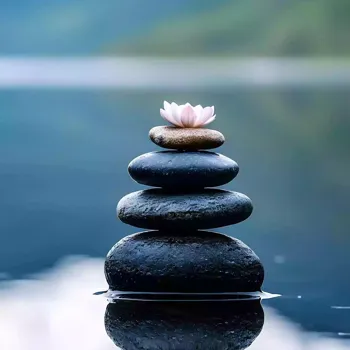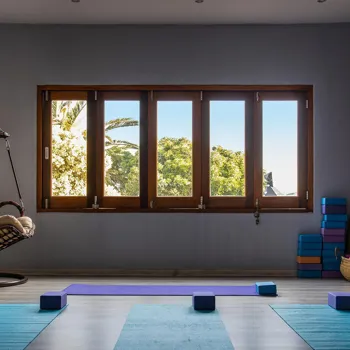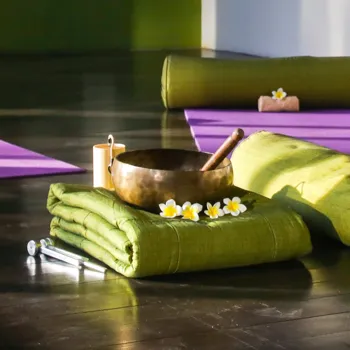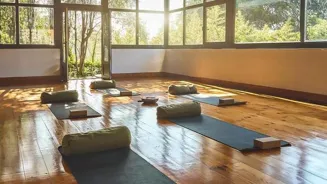Dive into the world of meditation techniques in India. Find your perfect fit for peace and well-being
In today's fast-paced world, where stress and anxiety seem to be constant companions, many Indians are
turning to meditation for a much-needed dose of peace and well-being. But with a plethora of meditation techniques available, knowing where to begin can feel overwhelming. Fear not!

This article will guide you through some popular meditation styles, helping you discover the perfect fit for your personality and lifestyle. After all, finding the right meditation technique is like finding the perfect cup of chai – it just feels right!
Meditation in India offers grounding amidst chaos
Let's be honest, life in India can get a bit... much, no? From battling traffic jams that test our patience to juggling family responsibilities and work deadlines, it's no wonder we feel like our minds are constantly buzzing.
Mediation can help calm that internal chaos, providing a sense of grounding and clarity amidst the storm. Mediation is more than just sitting crossed-legged and humming "om". Finding the right type of meditation for your needs can be really a game changer.
Mindfulness meditation: focus on present moment, observe without judgment
Mindfulness meditation is perhaps the most well-known and widely practiced technique. At its core, it's all about paying attention to the present moment without judgment. Imagine yourself sipping a hot cup of chai.

Instead of mentally planning your day or replaying a conversation, you focus solely on the aroma, the warmth in your hands, and the taste of each sip. That’s mindfulness in action!
It trains your mind to observe thoughts, feelings, and bodily sensations as they arise, accepting them without getting carried away. There are many teachers available now a days to learn the right way of doing it. They can guide you slowly into this world with care and patience.
Mindfulness meditation: accessible, anchor in present moment, no equipment needed
Mindfulness meditation is brilliant for beginners because it doesn't require any special equipment or training. You can practice it anywhere, anytime – while commuting on the local train (though maybe not during rush hour!), waiting in a queue, or even while washing dishes.
The key is to simply bring your awareness back to the present whenever your mind wanders. Just observe the thoughts with non judgemental eye.
It’s all about gently bringing your attention back to the anchor of the present moment, whether it's your breath, the sounds around you, or the sensations in your body. There are many online recourses that can help with this meditation.
TM uses mantra to quiet the mind; guidance is key
Transcendental Meditation, or TM, is another popular technique that involves using a mantra – a specific word or sound – to quiet the mind. Unlike mindfulness, where you observe your thoughts, TM encourages you to gently guide your attention back to the mantra whenever your mind wanders.

This mantra is typically provided by a certified TM teacher and is meant to be kept private. No one can teach it better then the professional so don't try to learn it with videos. You might end up doing it in an incorrect way.
TM offers simple, effortless meditation for relaxation and peace
The beauty of TM lies in its simplicity and ease of practice. It doesn't require any concentration or effort. You simply sit comfortably with your eyes closed and repeat the mantra silently.

The mantra acts as a mental anchor, helping to soothe and quiet the mind, allowing you to drift into a state of deep relaxation and inner peace. TM is often praised for its ability to reduce stress, improve focus, and enhance overall well-being. This helps people to clam down anxiety.
Guided meditation offers soothing instructions for mental relaxation
If you find it difficult to meditate in silence, guided meditation might be the perfect solution. In this type of meditation, a narrator leads you through a visualization or a series of relaxing instructions. Think of it as having a friendly voice guiding you on a mental journey.

The narrator might ask you to imagine a peaceful scene, focus on your breath, or direct your attention to different parts of your body. A person can learn a lot with guided meditation and find the right track for them.
Guided meditations online offer structure for beginners
Guided meditations are readily available online, often focusing on specific themes such as stress reduction, sleep improvement, or self-compassion. The possibilities are endless! The beauty of guided meditation is that it provides structure and support, making it easier to stay focused and engaged.

It's a great option for those who are new to meditation or who find it challenging to quiet their minds on their own. It is beneficial for the one who want to start this journey.
Walking meditation: mindfulness through walking, focusing on sensations
Believe it or not, you can meditate while walking! Walking meditation involves paying attention to the physical sensations of walking – the feeling of your feet touching the ground, the movement of your body, the rhythm of your breath.

It's a wonderful way to combine physical activity with mindfulness, engaging your senses and bringing you into the present moment.
Walking meditation promotes mindfulness and grounding
While it sounds simple, walking meditation requires focus and intention. You might choose a quiet path in a park or even walk around your house.

The key is to walk at a slow, comfortable pace and to focus on the sensations of walking, allowing your thoughts to drift by without getting caught up in them.
Walking meditation can be a great option for those who find it difficult to sit still for extended periods or who want to incorporate mindfulness into their daily routine. It helps to ground you from all the un pleasant thoughts.
Yoga and meditation complement each other, enhancing calmness and peace
Yoga and meditation are often practiced together, complementing each other beautifully. Yoga asanas (postures) help to prepare the body for meditation by releasing tension and improving flexibility.

The physical practice of yoga can also help to calm the mind and bring you into the present moment, making it easier to transition into a meditative state. It makes you feel so clam and brings piece.
Yoga classes end with meditation for mind-body benefits
Many yoga classes incorporate a short meditation session at the end of the practice, allowing you to integrate the benefits of both disciplines.

Whether you’re a seasoned yogi or a complete beginner, incorporating meditation into your yoga routine can deepen your practice and enhance your overall well-being. When you do yoga with meditation you kind of calm down your mind which is excellent for your health.
Experiment to find the right meditation type for you, not one-size-fits-all
The key to finding the right type of meditation is to experiment and explore. There's no one-size-fits-all approach. What works for your friend might not work for you. Try different techniques, explore various apps and online resources, and see what resonates with you.

Meditation is not a competition, it is for your well being.
Develop patience in meditation, be kind to yourself, seek guidance, never give up
Don't be discouraged if you don't find the perfect technique right away. It takes time and patience to develop a consistent meditation practice. The most important thing is to be kind to yourself and to approach meditation with an open mind and a willing heart.

There are many teacher that can help you in this journey. So keep looking and never give up on yourself. Because you are strong and can reach you inner peace.
AI Generated Content. Glance/InMobi shall have no liability for the content










